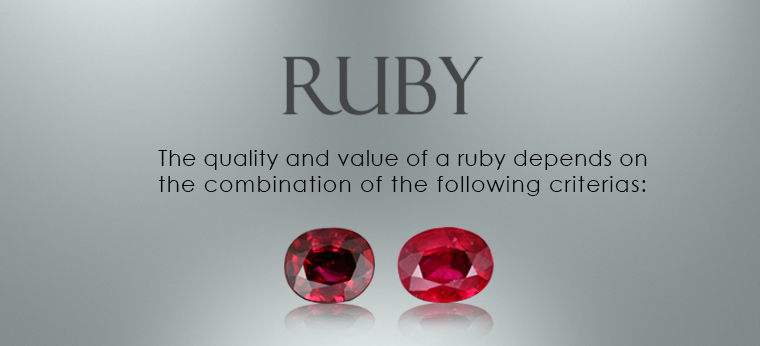
Ruby buying Guide
Carat
A ruby weight is measured in carats. 5 carats = 1 gram. Being equal, the greater carat weight, rareness of the ruby are other factors that increases’s or decreases a ruby’s value. Illustrated below is the approximate appearance of a well cut oval shaped ruby for a given carat weight.
Shape and cut
To optimize the natural rough, rubies are cut into a wide variety of shapes such as those illustrated below.
Profile
Cut refers to the accuracy of angles, proportions , symmetry and polish of the Ruby. It greatly affects how light travels within the ruby, and how it reflects in the form of brilliance.
Colour
Colour is a matter of personal preference. Rubies vary in colour depending mainly upon their chromium and iron content. Therefore sapphires from different countries* and mines have different predominant colours. Primarily red, rubies range from brownish and purplish shades to orangish and pinkish ones. But a natural colour will always have a greater value than an equivalent colour obtained by heating or other processes.
*Main countries where rubies are mined: Afghanistan, Cambodia, India, Kenya, Madagascar, Myanmar(Burma), Pakistan, Sri Lanka (Ceylon), Tajikistan, Tanzania, Thailand (Siam), Vietnam and Mazambique.
Origin
Where the gem originates from very much determines and effects its value and desirability. Certain specific mines are considered “better” than others even though the type of gem is from the same country. For example, Myanmar rubies from “mogok” gem mining areas are held in high esteem and much more sought after than rubies from “Mong shu” mine.
Likewise Columbian emeralds are the most popular choice on the whole than emeralds from Zambian. Kashmir and Burma sapphires over Sri Lanka and Madagascar.
Ask for the origin of the gemstone before you purchase however keep in mind that your final judgement should be based on your own criteria and purpose. Concentrate of the “merits” and “characteristics” of the gemstone with view to its physical, optical , and individual beauty of the stone.
Treatments
Gemstones are often treated to enhance its color and clarity thus improving its value and appearance. Ask if the gem of your interest has undergone any type of treatments such as heat, irradiation, oiling, dye, fracture filling and any combination or processes imposed onto the gem material.
Ask a reputable expert to guide you. Generally speaking, natural untreated gemstones command higher appreciation and are more expensive. However, some traditional treatments such as heat only for rubies and sapphires,zircons and cedar oil for emeralds are acceptable.
Inclusions
The clarity of a ruby is determined by the number , size and positions of inclusions which are natural materials present in the stone. Hey reflect its fascination geological aspects. There may be presence of the fissures, fractures and cavities which affects the clarity of rubies both internally and externally.
Transparency
Transparency refer to the ability of a ruby to transmit light. It is affected by the quantity or absence of opacity and brilliance present in the stone.
TAG Buy ruby, Sell ruby, Ruby buying guide, how to buy ruby, good ruby, fine ruby, Ruby grading, Beginner guide.















